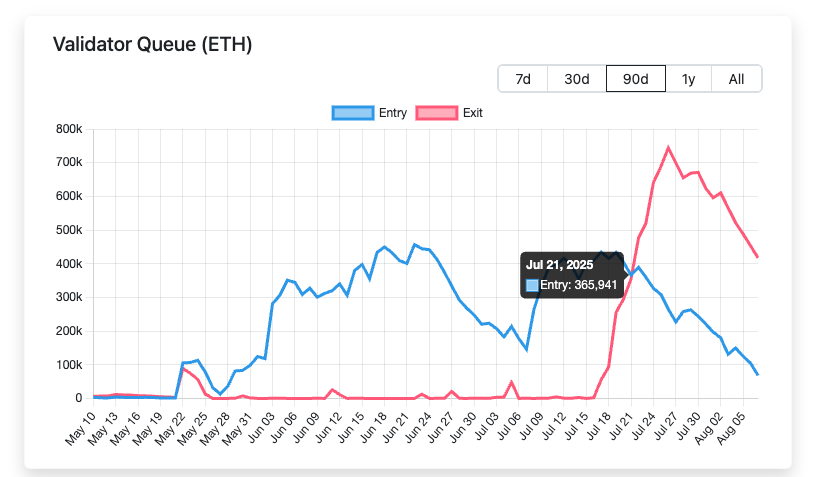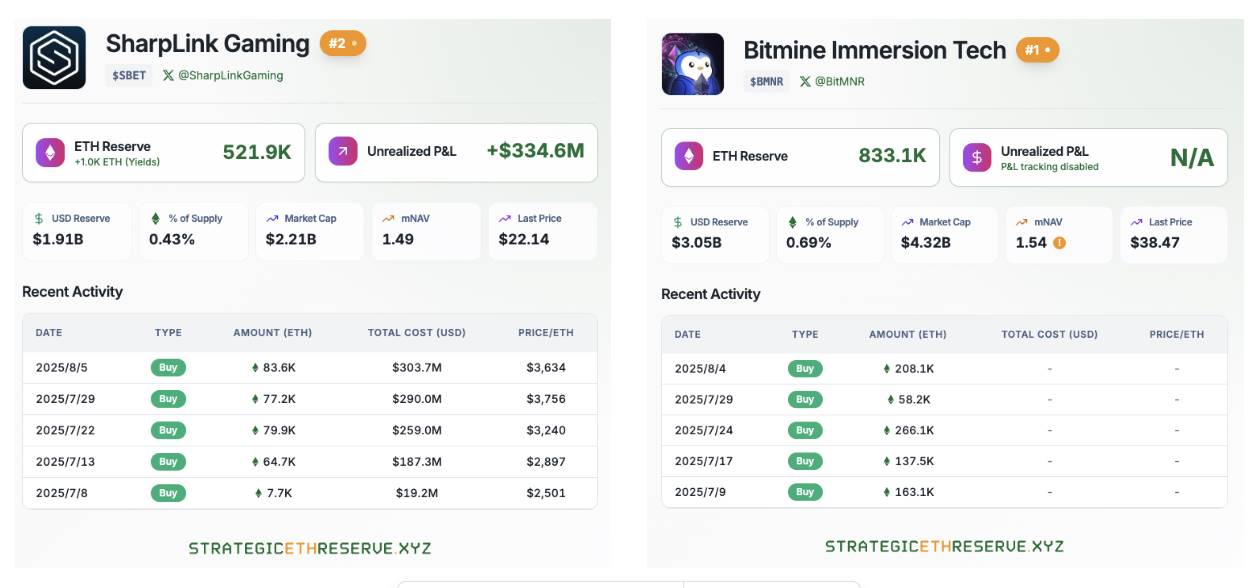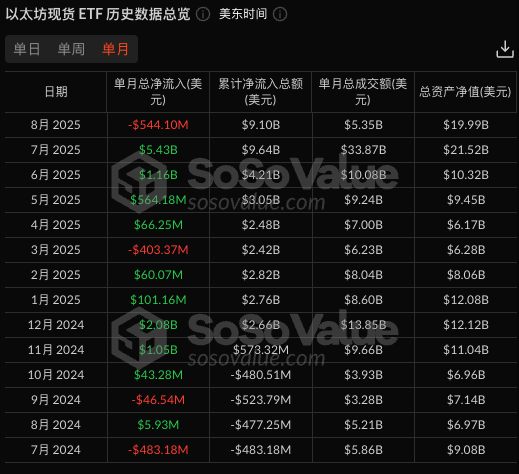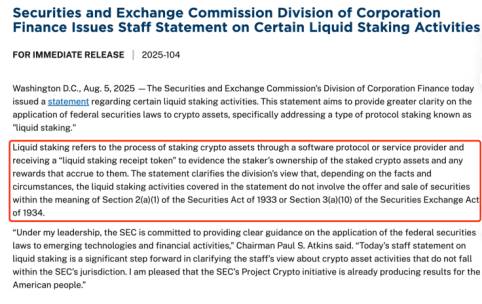As ETH continues to flow from retail investors to institutions, the survival space for decentralized staking platforms is being increasingly compressed.
Written by: Deep Tide TechFlow
On August 4, Vasiliy Shapovalov, co-founder of the decentralized staking platform Lido, announced a 15% layoff.
In a context where almost everyone believes an institution-driven ETH bull market is imminent, and the SEC has shown signs of approving ETH spot ETF staking applications, this news clearly contradicts expectations.
As one of the leading projects in the ETH staking space, Lido is likely seen by many as the biggest beneficiary of the SEC's approval of ETH staking ETFs, but is that really the case?
Lido's layoffs are not just a simple organizational adjustment; they reflect a turning point facing the entire decentralized staking sector.
The official explanation is "for long-term sustainability and cost control," but what it reveals is a deeper industry change:
As ETH continues to flow from retail investors to institutions, the survival space for decentralized staking platforms is being increasingly compressed.
Let’s rewind to 2020, when Lido was just launched, and ETH2.0 staking had just begun. The 32 ETH staking threshold deterred most retail investors, but Lido's innovation of liquid staking tokens (stETH) allowed anyone to participate in staking while maintaining liquidity. This simple and elegant solution enabled Lido to grow into a staking giant with a TVL exceeding $32 billion in just a few years.
However, changes in the crypto market over the past two years have shattered Lido's growth myth. As traditional financial giants like BlackRock began to enter the ETH staking space, institutional investors are reshaping the market using familiar methods. Key players in this institution-driven ETH bull market have provided their own solutions: BMNR chose Anchorage, SBET chose Coinbase Custody, and BlackRock's ETFs all adopted offline staking.
Without exception, they prefer centralized staking solutions over decentralized platforms. This choice is driven by compliance considerations and risk preferences, but the ultimate result points to one thing: the growth engine of decentralized staking platforms is "stalling."
Institutions to the left, decentralized staking to the right
To understand the logic behind institutional choices, we need to look at a set of data: starting from July 21, 2025, the number of ETH queued for unstaking began to significantly exceed the number entering staking, with the largest difference reaching 500,000 ETH.

At the same time, ETH strategic reserve companies led by BitMine and SharpLink are continuously purchasing ETH in large quantities, with these two companies alone holding over 1.35 million ETH.

Wall Street institutions like BlackRock are also continuously buying after the SEC approved the ETH spot ETF.

Based on the above data, it is undeniable that ETH is continuously flowing from retail investors to institutions. This drastic change in holding structure is redefining the game rules of the entire staking market.
For institutions managing billions of dollars in assets, compliance is always the top priority. When the SEC reviews BlackRock's ETH staking ETF application, it explicitly requires applicants to demonstrate the compliance, transparency, and auditability of their staking service providers.
This precisely hits the soft spot of decentralized staking platforms. Operators of decentralized staking platforms like Lido are distributed globally; while this decentralized structure enhances the network's resistance to censorship, it also makes compliance reviews extremely complex. Imagine when regulators require KYC information for each validator node, how will decentralized protocols respond?
In contrast, centralized solutions like Coinbase Custody are much simpler. They have clear legal entities, established compliance processes, traceable fund flows, and even insurance coverage. For institutional investors who need to report to LPs, the choice is obvious.
When evaluating staking solutions, institutional risk control departments focus on one core question: who is responsible if something goes wrong?
In Lido's model, losses caused by the mistakes of node operators will be borne collectively by all stETH holders, and it may be difficult to hold specific individuals accountable. However, in centralized staking, service providers bear clear compensation responsibilities and may even offer additional insurance protection.
More importantly, institutions need not only technical security but also operational stability. When Lido changes node operators through DAO voting, this "people's vote" becomes a source of uncertainty in the eyes of institutions. They prefer to choose a predictable and controllable partner.
Regulatory easing, but not entirely favorable
On July 30, the SEC announced it had received BlackRock's ETH staking ETF application. Just on August 5, the SEC released new guidelines: specific liquid staking does not fall under the jurisdiction of securities law.

It seems that everything is developing positively; on the surface, this is the long-awaited good news for decentralized staking platforms. However, a deeper analysis reveals that this could also be the sword of Damocles hanging over all decentralized staking platforms.
The short-term benefits brought by regulatory easing are evident. Mainstream decentralized staking platform tokens like Lido and ETHFI saw their prices surge over 3% immediately after the news was announced. As of August 7, the liquid staking asset PRL rose by 19.2% within 24 hours, and SWELL increased by 18.5%. The price increase reflects the market's optimistic expectations for the LSD sector, and more importantly, the SEC's statement has cleared compliance obstacles for institutional investors.
For a long time, traditional financial institutions have been primarily concerned about the potential risks of securities law when participating in staking activities. Now, this cloud has been largely dispelled, and it seems that SEC approval of ETH staking ETFs is just a matter of time.
However, behind this flourishing scene lies a deeper crisis in the sector.
The SEC's regulatory easing not only opens doors for decentralized platforms but also paves the way for traditional financial giants. When asset management giants like BlackRock begin to launch their own staking ETF products, decentralized platforms will face unprecedented competitive pressure.
The asymmetry of this competition lies in the disparity of resources and channels. Traditional financial institutions have established sales networks, brand trust, and compliance experience, which decentralized platforms find difficult to match in the short term.
More critically, the standardization and convenience of ETF products have a natural appeal to ordinary investors. When investors can purchase staking ETFs with a single click through familiar brokerage accounts, why would they go through the trouble of learning how to use decentralized protocols?
The core value proposition of decentralized staking platforms—decentralization and resistance to censorship—seems weak in the face of institutionalization. For institutional investors seeking to maximize returns, decentralization is more of a cost than an advantage. They are more concerned about yield, liquidity, and operational convenience, which are precisely the strengths of centralized solutions.
In the long run, regulatory easing may accelerate the "Matthew effect" in the staking market. Funds will increasingly concentrate on a few large platforms, while small decentralized projects will face survival crises.
A deeper threat lies in the disruption of business models. Traditional financial institutions can lower fees through cross-selling, economies of scale, and even offer zero-fee staking services. In contrast, decentralized platforms rely on protocol fees to maintain operations, putting them at a natural disadvantage in price wars. When competitors can subsidize staking services through other business lines, how will single-business model decentralized platforms respond?
Therefore, while the SEC's regulatory easing has brought opportunities for market expansion to decentralized staking platforms in the short term, in the long run, it seems more like opening Pandora's box.
The entry of traditional financial forces will fundamentally change the game rules, and decentralized platforms must find new ways to survive before being marginalized. This may mean more aggressive innovation, deeper DeFi integration, or—ironically—a certain degree of centralized compromise.
At this moment of regulatory spring, decentralized staking platforms may not be facing a time for celebration, but rather a turning point for survival.
The risks and opportunities of the Ethereum staking ecosystem
Standing at the critical juncture of 2025, the Ethereum staking ecosystem is undergoing unprecedented changes. Vitalik's concerns, regulatory shifts, and institutional entries—these seemingly contradictory forces are reshaping the entire industry landscape.
Indeed, challenges are real. The shadow of centralization, intensified competition, and disruptions to business models could each become the last straw that breaks the decentralized ideal. But history tells us that true innovation often arises from crises.
For decentralized staking platforms, the wave of institutionalization is both a threat and a driving force for innovation. When traditional financial giants bring standardized products, decentralized platforms can focus on deep integration within the DeFi ecosystem; when price wars become inevitable, differentiated services and community governance will become new moats; when regulation opens doors for everyone, the importance of technological innovation and user experience will become even more pronounced.
More importantly, the expansion of the market means the pie is getting bigger. When staking becomes a mainstream investment choice, even niche markets can support the prosperous development of multiple platforms. Decentralization and centralization do not have to be a zero-sum game; they can serve different user groups and meet different needs.
The future of Ethereum will not be determined by a single force but will be shaped by all participants together.
As tides rise and fall, only the fittest survive. In the crypto industry, the definition of "fittest" is far more diverse than in traditional markets, which may be the reason we should remain optimistic.
免责声明:本文章仅代表作者个人观点,不代表本平台的立场和观点。本文章仅供信息分享,不构成对任何人的任何投资建议。用户与作者之间的任何争议,与本平台无关。如网页中刊载的文章或图片涉及侵权,请提供相关的权利证明和身份证明发送邮件到support@aicoin.com,本平台相关工作人员将会进行核查。




